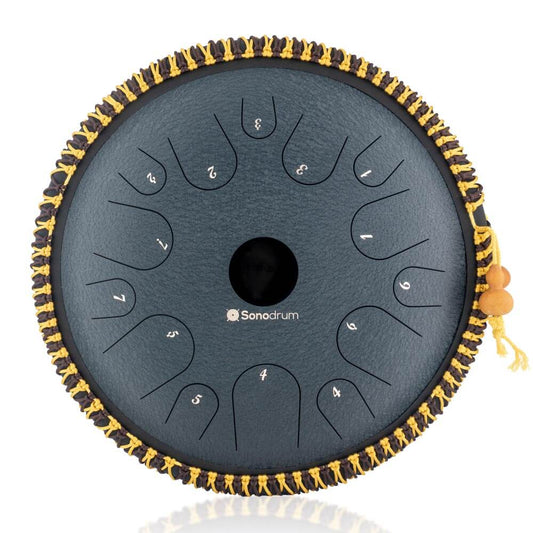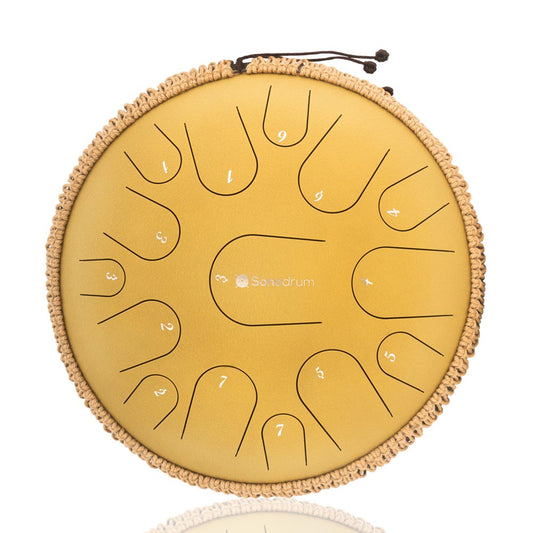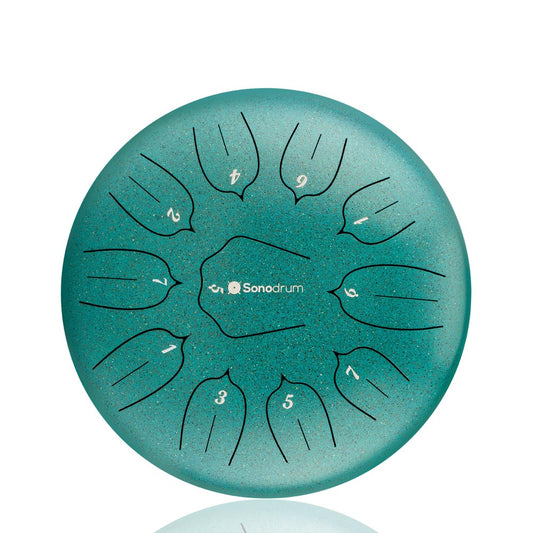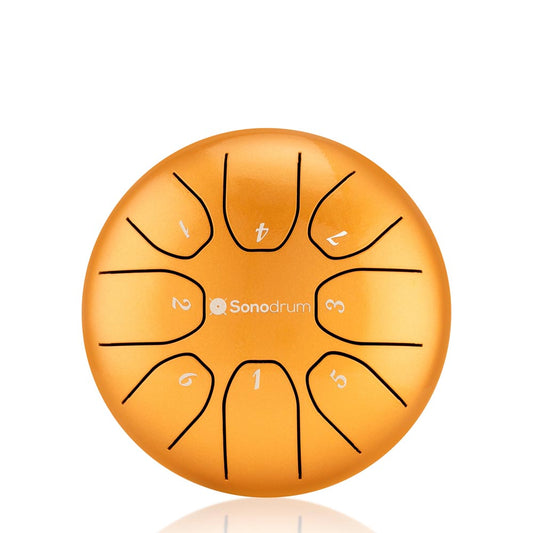Embarking on a journey of self-discovery through beginner's yoga and tongue drums can be a fulfilling experience. As you start yoga at home, you'll find that the combination of flowing poses and soothing sounds fosters a sense of mindfulness practice that nurtures both the body and mind. Regardless of your previous experience, this harmonious duo offers a unique opportunity to cultivate tranquility and overall well-being.
As many wellness enthusiasts discover the benefits of home practice, it's evident that creating an inviting space for yoga and music can enhance your personal journey. In the cozy atmosphere of your home, you can allow yourself the freedom to explore, grow, and connect with these enriching disciplines. Whether it's the gentle rhythm of the tongue drum or the calming effects of yoga, initiating this practice will surely lead you to a more balanced and fulfilling lifestyle.
Key Takeaways
- Beginner's yoga and tongue drums create a unique blend for mindfulness.
- Starting a home practice requires no prior experience.
- Creating a welcoming space enhances your practice and enjoyment.
- This journey fosters physical and mental well-being.
- Many wellness enthusiasts are embracing home yoga and music.
Understanding the Benefits of Beginner's Yoga
Engaging in yoga can significantly improve one's life, particularly for those who are just starting their journey. The yoga benefits extend beyond mere fitness, encompassing various aspects of both physical and mental wellness.
Physical Benefits of Yoga for Beginners
For beginners, the beginner yoga advantages manifest prominently in physical health. Regular practice enhances flexibility, allowing individuals to perform daily activities with greater ease. Furthermore, yoga promotes strength and balance, essential traits for overall well-being. An increase in circulation not only energizes the body but also contributes to a healthier heart.
Research indicates that dedicated practice can lead to improved posture and reduced tension in the body, pivotal for maintaining physical health. As each pose is executed, muscles strengthen and soreness is alleviated, creating a balanced state of relaxation and vigor.
Mental Health Advantages of Practicing Yoga
The impact of yoga on mental health is equally profound. Many find that yoga serves as a powerful tool for stress relief, helping individuals manage anxiety and promote a more positive outlook. Mindfulness cultivated through yoga enhances mood and encourages emotional balance. Studies reveal that consistent practice can lead to a higher level of life satisfaction and emotional resilience.
Incorporating yoga into daily routines can foster a sense of calm and well-being, making it an ideal practice for anyone seeking to enhance both physical and mental health.
Exploring Tongue Drums and Their Healing Qualities
Tongue drums, captivating musical instruments for wellness, have gained popularity due to their soothing sounds and versatile applications. Constructed from various materials such as metal or wood, these instruments come in different sizes and tunings, producing unique tones that resonate deeply with the listener. Their design allows for the creation of harmonious and melodic vibrations, which can significantly enhance relaxation techniques.
Introduction to Tongue Drums: What They Are
Originating from various cultures around the world, tongue drums have evolved to blend traditional craftsmanship with modern aesthetics. The circular shape of the drum and the cut-out tongues contribute to the rich, resonant sounds that can be soothing to the mind and body. As a musical instrument for wellness, tongue drums encourage creativity and self-expression, often used in personal meditation practices and group settings alike.
The Therapeutic Benefits of Sound Healing
Sound healing is the practice of using therapeutic sounds to promote physical and emotional well-being. Research indicates that these therapeutic sounds can help lower anxiety levels, facilitating a more relaxed state of mind. Incorporating sound healing into your routine can enhance meditation and create an atmosphere conducive to yoga practices. The gentle tones produced by tongue drums aid in stress reduction, allowing individuals to connect more deeply with their inner selves and achieve a profound sense of peace.
Setting Up Your Home Yoga and Tongue Drum Space
Creating a peaceful and inviting home yoga space for both yoga and tongue drum practice starts with selecting the right environment for practice. The atmosphere significantly influences your ability to stay focused and present during your sessions. Consider aspects like natural light, calming colors, and a temperature that feels comfortable. Surrounding yourself with elements that promote tranquility will help you foster a mindful practice space where you can truly connect with your body and mind.
Choosing the Right Environment for Your Practice
When setting up your home yoga space, think about the layout and flow of the area. Look for a room that offers minimal distractions. Quiet corners or rooms with calming views can provide a perfect backdrop. Personal touches such as plants, candles, and art can enhance the atmosphere. Consider including a tongue drum setup that aligns with your aesthetic and adds a soothing sound quality to the environment. Remember, the goal is to create a serene ambiance conducive to both yoga and musical exploration.
Essential Tools and Equipment You’ll Need
To fully engage in your practice, certain yoga essentials will enhance your experience. Here’s a breakdown of must-have items:
| Equipment | Description |
|---|---|
| Yoga Mat | A stable surface for comfort and grip. |
| Yoga Blocks | Support to modify poses and enhance flexibility. |
| Yoga Straps | Assists with alignment and deeper stretches. |
| Tongue Drum | A melodic instrument for creating soothing sounds during practice. |
| Comfortable Clothing | Wear breathable, flexible apparel to move freely. |
Decluttering your space will allow you to focus. Remove anything that doesn’t serve your practice, and consider adding meaningful items like pictures or tokens that inspire you. Balance functionality with a personal touch to ensure your home yoga space becomes a cherished environment for practice.
Beginner’s Guide to Yoga and Tongue Drums: Starting a Practice at Home
Starting a yoga practice at home brings a wonderful opportunity to explore the combination of beginner yoga poses alongside the soothing sounds of tongue drums. Integrating music with yoga not only enhances the overall experience but also deepens the connection to sound and movement. This section introduces simple yoga practice steps that can be easily followed, allowing for a harmonious blend of mindful movement and melodic play.
Integrating Yoga Poses with Tongue Drum Play
As you begin to weave together yoga poses with tongue drum playing, choose beginner yoga poses that establish a balanced foundation. Poses such as Mountain Pose, Child’s Pose, and Downward Facing Dog work well to ground the body while drumming.
- Mountain Pose: Stand tall and breathe deeply, allowing your drum to resonate with your heartbeat.
- Child’s Pose: While in this comforting pose, play gentle rhythms that evoke relaxation.
- Downward Facing Dog: Use a steady drumming pattern to create energy and flow as you transition to this pose.
Each of these beginner yoga poses creates a unique rhythm that can be matched with the beats of the tongue drum, enriching your practice and fostering a sound experience.
Step-by-Step Guide for Beginners
To begin your home practice guide, follow these simple yoga practice steps that allow for a seamless transition between poses and musical play:
- Start in Mountain Pose, focusing on your breath. Strike the drum gently to establish a rhythm.
- Move into Child’s Pose, maintaining your drumming while relaxing into the stretch.
- Shift to Downward Facing Dog while drumming to the beat of your breath, creating a flow of energy.
- Return to Mountain Pose and conclude with a calming sound pattern to ground your practice.
With practice, these elements can blend beautifully, enhancing both your physical and emotional experience. This journey encourages self-exploration, allowing you to find personal rhythms and movements that resonate with your unique practice.
Creating a Consistent Home Practice Routine
Establishing a consistent home practice routine is crucial for those beginning yoga and learning to play tongue drums. With proper time management for practice, individuals can integrate sessions into their daily lives without feeling overwhelmed. Identifying the optimal time for practicing can lead to enhanced focus and more significant overall benefits.
Finding the Right Time for Your Practice
Choosing the right time for your practice often depends on personal schedules and energy levels. Some people may find mornings ideal for a fresh start to their day, allowing for calm introspection and physical movement. Others might prefer evenings, using the practice as a way to unwind. Listen to your body and assess when you feel most motivated and energized to create a sustainable routine.
How to Track Your Progress Over Time
Tracking progress is essential in cultivating consistency in yoga and music practices. Consider keeping a journal to document your sessions, focusing on what you learned and felt during each practice. Utilizing apps designed for yoga and creative arts can help you monitor improvements, visualize growth, and maintain motivation. Take time to reflect after each session; this fosters awareness and enhances your approach, leading to a more fulfilling practice routine.
Tips for Staying Motivated in Your Practice
Maintaining motivation for yoga and integrating your practice with tongue drums can sometimes be challenging. By exploring various methods, practitioners can enhance their dedication and enjoyment. Connecting with others who share similar interests can markedly elevate the experience.
Joining Online Communities for Support
Online yoga communities provide an excellent platform for receiving support in wellness. Engaging with fellow yoga enthusiasts opens doors for sharing experiences, tips, and encouragement. Inviting this social aspect into your practice can create a motivating environment. Consider participating in forums or platforms where you can discuss progress and seek advice.
Setting Realistic Goals for Your Yoga and Music Journey
Setting goals for practice is crucial for sustaining enthusiasm and progress. Break down larger objectives into achievable steps. Aim for milestones that are specific, measurable, and time-bound. Celebrating small achievements helps reinforce motivation for yoga and keeps the practice enjoyable. Remember, every step forward, no matter how minor, contributes to your overall growth.

By blending the power of community support with clear objectives, practitioners can experience a more fulfilling journey in their yoga and musical endeavors. Embrace each moment as a chance to evolve and delight in the process.
Conclusion
As we wrap up this beginner's guide recap, it's clear that integrating yoga and tongue drums offers a profound opportunity for personal growth and relaxation. This summary of yoga and tongue drums highlights the benefits of home practice, emphasizing both physical and mental enhancements that can be gained through consistent effort.
Embarking on this mindful journey allows individuals to find tranquility and resilience within themselves, nurtured through the combination of gentle movement and soothing sounds. Whether you're just beginning or looking to deepen your practice, embracing the rhythm of these elements can foster a fulfilling routine that supports overall well-being.
Take it one step at a time, celebrate your progress, and remember that each practice brings you closer to a state of inner peace. As you explore this enriching combination, let your home practice evolve and adapt to your needs while seeking out additional resources for continuous learning and growth.
FAQ
What are the best yoga poses for beginners?
Some great yoga poses for beginners include Child's Pose, Downward Dog, and Cat-Cow. These poses help improve flexibility, strength, and balance while fostering a sense of calm.
Can I use a tongue drum during my yoga practice?
Absolutely! Incorporating a tongue drum into your yoga practice can enhance relaxation and mindfulness. The soothing sounds can help you focus and deepen your meditation experience.
Do I need any special equipment for home yoga and tongue drum practices?
Essential equipment includes a yoga mat, yoga blocks, and a tongue drum. Personal touches, like calming decorations or scented candles, can also create a welcoming atmosphere.
How often should I practice yoga at home?
Aim for at least 2-3 times per week to start. Developing a consistent routine, even if it's just 15-30 minutes per session, can significantly benefit your physical and mental well-being.
What are the mental health benefits of practicing yoga?
Practicing yoga can alleviate stress, reduce anxiety, and enhance your mood by promoting mindfulness and emotional resilience. Many practitioners report greater overall life satisfaction.
How do I create a peaceful space for my yoga and tongue drum practice?
Choose a quiet room with good lighting and ventilation. Consider decluttering and personalizing the space with items that inspire you, such as plants or artwork, to foster tranquility.
Can I track my progress in yoga and tongue drum skills over time?
Yes! Keeping a journal or using tracking apps can help you monitor your progress and celebrate achievements, encouraging you to stay committed to your practice.
How can online communities support my yoga and music journey?
Joining online communities allows you to connect with fellow enthusiasts, share experiences, and receive encouragement, which can enhance motivation and create a sense of belonging in your wellness journey.




